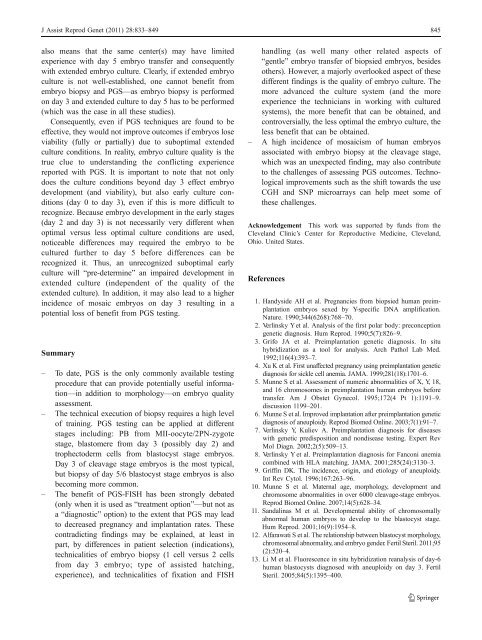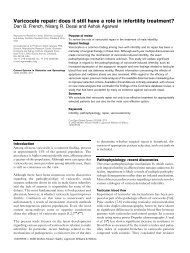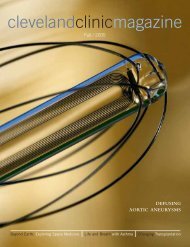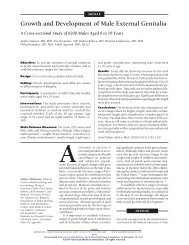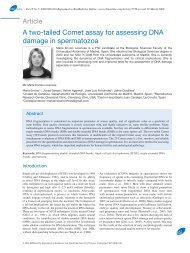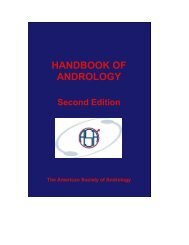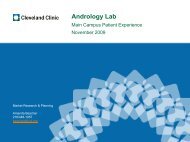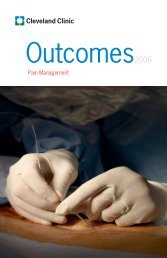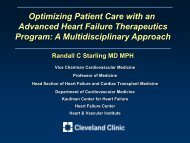Preimplantation genetic screening: does it help or ... - ResearchGate
Preimplantation genetic screening: does it help or ... - ResearchGate
Preimplantation genetic screening: does it help or ... - ResearchGate
Create successful ePaper yourself
Turn your PDF publications into a flip-book with our unique Google optimized e-Paper software.
J Assist Reprod Genet (2011) 28:833–849 845<br />
also means that the same center(s) may have lim<strong>it</strong>ed<br />
experience w<strong>it</strong>h day 5 embryo transfer and consequently<br />
w<strong>it</strong>h extended embryo culture. Clearly, if extended embryo<br />
culture is not well-established, one cannot benef<strong>it</strong> from<br />
embryo biopsy and PGS—as embryo biopsy is perf<strong>or</strong>med<br />
on day 3 and extended culture to day 5 has to be perf<strong>or</strong>med<br />
(which was the case in all these studies).<br />
Consequently, even if PGS techniques are found to be<br />
effective, they would not improve outcomes if embryos lose<br />
viabil<strong>it</strong>y (fully <strong>or</strong> partially) due to suboptimal extended<br />
culture cond<strong>it</strong>ions. In real<strong>it</strong>y, embryo culture qual<strong>it</strong>y is the<br />
true clue to understanding the conflicting experience<br />
rep<strong>or</strong>ted w<strong>it</strong>h PGS. It is imp<strong>or</strong>tant to note that not only<br />
<strong>does</strong> the culture cond<strong>it</strong>ions beyond day 3 effect embryo<br />
development (and viabil<strong>it</strong>y), but also early culture cond<strong>it</strong>ions<br />
(day 0 to day 3), even if this is m<strong>or</strong>e difficult to<br />
recognize. Because embryo development in the early stages<br />
(day 2 and day 3) is not necessarily very different when<br />
optimal versus less optimal culture cond<strong>it</strong>ions are used,<br />
noticeable differences may required the embryo to be<br />
cultured further to day 5 bef<strong>or</strong>e differences can be<br />
recognized <strong>it</strong>. Thus, an unrecognized suboptimal early<br />
culture will “pre-determine” an impaired development in<br />
extended culture (independent of the qual<strong>it</strong>y of the<br />
extended culture). In add<strong>it</strong>ion, <strong>it</strong> may also lead to a higher<br />
incidence of mosaic embryos on day 3 resulting in a<br />
potential loss of benef<strong>it</strong> from PGS testing.<br />
Summary<br />
– To date, PGS is the only commonly available testing<br />
procedure that can provide potentially useful inf<strong>or</strong>mation—in<br />
add<strong>it</strong>ion to m<strong>or</strong>phology—on embryo qual<strong>it</strong>y<br />
assessment.<br />
– The technical execution of biopsy requires a high level<br />
of training. PGS testing can be applied at different<br />
stages including: PB from MII-oocyte/2PN-zygote<br />
stage, blastomere from day 3 (possibly day 2) and<br />
trophectoderm cells from blastocyst stage embryos.<br />
Day 3 of cleavage stage embryos is the most typical,<br />
but biopsy of day 5/6 blastocyst stage embryos is also<br />
becoming m<strong>or</strong>e common.<br />
– The benef<strong>it</strong> of PGS-FISH has been strongly debated<br />
(only when <strong>it</strong> is used as “treatment option”—but not as<br />
a “diagnostic” option) to the extent that PGS may lead<br />
to decreased pregnancy and implantation rates. These<br />
contradicting findings may be explained, at least in<br />
part, by differences in patient selection (indications),<br />
technical<strong>it</strong>ies of embryo biopsy (1 cell versus 2 cells<br />
from day 3 embryo; type of assisted hatching,<br />
experience), and technical<strong>it</strong>ies of fixation and FISH<br />
handling (as well many other related aspects of<br />
“gentle” embryo transfer of biopsied embryos, besides<br />
others). However, a maj<strong>or</strong>ly overlooked aspect of these<br />
different findings is the qual<strong>it</strong>y of embryo culture. The<br />
m<strong>or</strong>e advanced the culture system (and the m<strong>or</strong>e<br />
experience the technicians in w<strong>or</strong>king w<strong>it</strong>h cultured<br />
systems), the m<strong>or</strong>e benef<strong>it</strong> that can be obtained, and<br />
controversially, the less optimal the embryo culture, the<br />
less benef<strong>it</strong> that can be obtained.<br />
– A high incidence of mosaicism of human embryos<br />
associated w<strong>it</strong>h embryo biopsy at the cleavage stage,<br />
which was an unexpected finding, may also contribute<br />
to the challenges of assessing PGS outcomes. Technological<br />
improvements such as the shift towards the use<br />
CGH and SNP microarrays can <strong>help</strong> meet some of<br />
these challenges.<br />
Acknowledgement This w<strong>or</strong>k was supp<strong>or</strong>ted by funds from the<br />
Cleveland Clinic’s Center f<strong>or</strong> Reproductive Medicine, Cleveland,<br />
Ohio. Un<strong>it</strong>ed States.<br />
References<br />
1. Handyside AH et al. Pregnancies from biopsied human preimplantation<br />
embryos sexed by Y-specific DNA amplification.<br />
Nature. 1990;344(6268):768–70.<br />
2. Verlinsky Yet al. Analysis of the first polar body: preconception<br />
<strong>genetic</strong> diagnosis. Hum Reprod. 1990;5(7):826–9.<br />
3. Grifo JA et al. <strong>Preimplantation</strong> <strong>genetic</strong> diagnosis. In s<strong>it</strong>u<br />
hybridization as a tool f<strong>or</strong> analysis. Arch Pathol Lab Med.<br />
1992;116(4):393–7.<br />
4. Xu K et al. First unaffected pregnancy using preimplantation <strong>genetic</strong><br />
diagnosis f<strong>or</strong> sickle cell anemia. JAMA. 1999;281(18):1701–6.<br />
5. Munne S et al. Assessment of numeric abn<strong>or</strong>mal<strong>it</strong>ies of X, Y, 18,<br />
and 16 chromosomes in preimplantation human embryos bef<strong>or</strong>e<br />
transfer. Am J Obstet Gynecol. 1995;172(4 Pt 1):1191–9.<br />
discussion 1199–201.<br />
6. Munne S et al. Improved implantation after preimplantation <strong>genetic</strong><br />
diagnosis of aneuploidy. Reprod Biomed Online. 2003;7(1):91–7.<br />
7. Verlinsky Y, Kuliev A. <strong>Preimplantation</strong> diagnosis f<strong>or</strong> diseases<br />
w<strong>it</strong>h <strong>genetic</strong> predispos<strong>it</strong>ion and nondisease testing. Expert Rev<br />
Mol Diagn. 2002;2(5):509–13.<br />
8. Verlinsky Y et al. <strong>Preimplantation</strong> diagnosis f<strong>or</strong> Fanconi anemia<br />
combined w<strong>it</strong>h HLA matching. JAMA. 2001;285(24):3130–3.<br />
9. Griffin DK. The incidence, <strong>or</strong>igin, and etiology of aneuploidy.<br />
Int Rev Cytol. 1996;167:263–96.<br />
10. Munne S et al. Maternal age, m<strong>or</strong>phology, development and<br />
chromosome abn<strong>or</strong>mal<strong>it</strong>ies in over 6000 cleavage-stage embryos.<br />
Reprod Biomed Online. 2007;14(5):628–34.<br />
11. Sandalinas M et al. Developmental abil<strong>it</strong>y of chromosomally<br />
abn<strong>or</strong>mal human embryos to develop to the blastocyst stage.<br />
Hum Reprod. 2001;16(9):1954–8.<br />
12. Alfarawati S et al. The relationship between blastocyst m<strong>or</strong>phology,<br />
chromosomal abn<strong>or</strong>mal<strong>it</strong>y, and embryo gender. Fertil Steril. 2011;95<br />
(2):520–4.<br />
13. Li M et al. Flu<strong>or</strong>escence in s<strong>it</strong>u hybridization reanalysis of day-6<br />
human blastocysts diagnosed w<strong>it</strong>h aneuploidy on day 3. Fertil<br />
Steril. 2005;84(5):1395–400.


